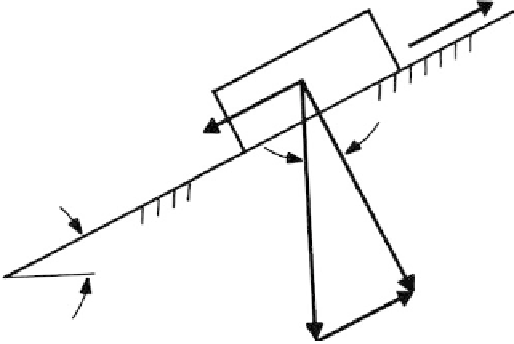Environmental Engineering Reference
In-Depth Information
Seepage parallel to slope with free water surface coincident with the ground sur-
face
(Figure 9.64c-
f)
:
i
●
1/2
φ
', and
T
(
N
'
U
)tan
φ
.
Infinite-slope conditions can exist in soils with cohesion which serves to increase
the stable slope angle
i
. These conditions generally occur where the thickness of
the stratum and, therefore, the position of the failure surface that can develop,
are limited by a lower boundary of stronger material. Many colluvial and clay
shale slopes are found in nature at
i
●
φ
r
, the case of seepage parallel to the
slope with the free water surface coincident with the ground surface.
1/2
Finite Slope: Planar Failure Surface
Case 1
: Single planar failure surface with location assumed, involving a single block and
no water pressures
(Figure 9.65).
Driving force
F
(
W
sin
i
) is the block weight component.
Resisting force
T
N
tan
φ
(
W
cos
i
) tan
φ
,
FS
(
W
cos
i
) tan
φ
/
W
sin
i
(9.7)
where
i
cr
φ.
Case 2
: Single block with cleft-water pressures and cohesion along the failure surface
with location assumed
(Figure 9.66):
FS
[
cA
(
W
cos
i
U
) tan
φ
]/
W
sin
i
V
(9.8)
where
A
is the block base area,
V
the total joint water pressure on upstream face of the
block,
U
the total water pressure acting on the base area (boundary water pressures),
c
the
cohesion, independent of normal stress, acting over the base area and
W
the total weight
of block, based on
γ
t
.
Case 3
: Simple wedge acting along one continuous failure surface with cohesion and
water pressure; failure surface location known
(Figure 9.67)
:
FS
[
cL
(
W
cos
θ
U
) tan
φ
]/
W
sin
θ
(9.9)
where
L
is the length of failure surface.
Case 4
: Simple wedge with tension crack and cleft-water pressures
V
and
U
. Failure sur-
face location known; tension crack beyond slope crest
(Figure 9.68a);
tension crack along
f N
F
N
W
i
cr
S
FIGURE 9.65
Simple sliding block.
N
tan



